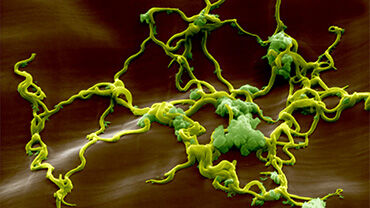An integrated database on ticks and tick-borne zoonoses in the tropics and subtropics with special reference to developing and emerging countriesArchived
Tick-borne zoonoses (TBZ) are emerging diseases worldwide. A large amount of information (e.g. case reports, results of epidemiological surveillance, etc.) is dispersed through various reference sources (ISI and non-ISI journals, conference proceedings, technical reports, etc.).
Vesco U(1), Knap N(2), Labruna MB(3), Avšič-Županc T(2), Estrada-Peña A(4), Guglielmone AA(5), Bechara GH, Gueye A(6), Lakos A(7), Grindatto A(1), Conte V(1), De Meneghi D(1) Experimental and Applied Acarology 2010 Dec 12; DOI: 10.1007/s10493-010-9414-4 [Epub ahead of print]
Tick-borne zoonoses (TBZ) are emerging diseases worldwide. A large amount of information (e.g. case reports, results of epidemiological surveillance, etc.) is dispersed through various reference sources (ISI and non-ISI journals, conference proceedings, technical reports, etc.). An integrated database-derived from the ICTTD-3 project -was developed in order to gather TBZ records in the (sub-)tropics, collected both by the authors and collaborators worldwide. A dedicated website was created to promote collaboration and circulate information. Data collected are made freely available to researchers for analysis by spatial methods, integrating mapped ecological factors for predicting TBZ risk. The authors present the assembly process of the TBZ database: the compilation of an updated list of TBZ relevant for (sub-)tropics, the database design and its structure, the method of bibliographic search, the assessment of spatial precision of geo-referenced records. At the time of writing, 725 records extracted from 337 publications related to 59 countries in the (sub-) tropics, have been entered in the database. TBZ distribution maps were also produced. Imported cases have been also accounted for. The most important datasets with geo-referenced records were those on Spotted Fever Group rickettsiosis in Latin-America and Crimean-Congo Haemorrhagic Fever in Africa. The authors stress the need for international collaboration in data collection to update and improve the database. Supervision of data entered remains always necessary. Means to foster collaboration are discussed. The paper is also intended to describe the challenges encountered to assemble spatial data from various sources and to help develop similar data collections.
VBORNET comment: 2011-17-02
This is an interesting paper presenting one of the outputs of the ICTTD initiative: the building of a database on TBZ in tropics and subtropics reporting as much as possible information available about TBZ occurrences in this region (pathogen species, geo-location, date or time period, diagnosis method, type of data -passive or active surveillance, human or animal or tick sample-, vectors and reservoirs if possible...).This initiative is very similar to those currently in Europe by EFSA and ECDC on animal and human TBD, respectively. They all show that there is a common interest to develop tools to synthesize epidemiological data useful for decision makers, surveillance systems and scientists and to keep available both historical information and unpublished results. However, such initiatives point out several new questions: (i) Should we develop only a consultative tool or also a tool that allows data uploading (ii) How to deal with data validation coming from unknown or not referenced experts (iii) And also how to deal with the evolution of pathogen or vector systematics and also the progress in diagnostic methods, even consensus identification or diagnosis techniques have been previously defined (iv) How to encourage experts to deposit their data and to avoid providing “a nice empty box” to public (v) How to organize non homogeneous datasets with different reporting dates, different sampling method or different spatial resolutions for example, with the crucial need to avoid “over-interpretation” of non accurate data (vi) And finally, after first basic recording effort to create the database, how to organize the epidemiological watch to update the database and the resulting reporting maps
References:
- Università degli Studi di Torino, Via Leonardo da Vinci, 44, 10095, Grugliasco, TO, Italy.
- Univerza v Lihbliani, Lubljana, Slovenia.
- Universidade de Sao Paulo, San Paulo, Brazil.
- Universidad de Zaragoza, Zaragoza, Spain.
- Instituto Nacional de Tecnologia Agropecuaria, Rafaela, Argentina.
- Institut Senegalais de Recherches Agricoles, Dakar, Senegal.
- Center for Tick-borne Diseases, Budapest, Hungary.





